Agaya Gangai and Lizard: Difference between pages
Adding geodata: {{coord missing|India}} |
No edit summary |
||
| Line 1: | Line 1: | ||
seema i see you |
|||
{{Infobox Waterfall |
|||
| name = Agaya Gangai Falls |
|||
{{Distinguish|House lizard|Gecko}} |
|||
| image = Agaya Gangai.JPG |
|||
| image_size = 180px |
|||
{{Otheruses}} |
|||
| caption = |
|||
| latitude = 11.17 |
|||
{{Taxobox |
|||
| longitude = 78.40 |
|||
| fossil_range = {{Fossil range|199|0|earliest=|latest=|PS=}}Jurassic - Present |
|||
| elevation = |
|||
| image = Bartagame fcm.jpg |
|||
| type = |
|||
| image_width = 240px |
|||
| height = |
|||
| image_caption = [[Central bearded dragon]], ''Pogona vitticeps'' |
|||
| height_longest = |
|||
| regnum = [[Animal]]ia |
|||
| average_width = |
|||
| phylum = [[Chordate|Chordata]] |
|||
| number_drops = |
|||
| superclassis = [[Tetrapoda]] |
|||
| average_flow = |
|||
| |
| classis = [[Reptile|Sauropsida]] |
||
| ordo = [[Squamata]] |
|||
| world_rank = |
|||
| subordo = '''Lacertilia'''[[Paraphyletic|*]] |
|||
| subordo_authority = [[Albert C. L. G. Günther|Günther]], 1867 |
|||
| subdivision_ranks = [[Family (biology)|Families]] |
|||
| subdivision = |
|||
Many, see [[Lizard#Classification|text]]. |
|||
}} |
}} |
||
'''''Lizards''''' are a large and widespread group of [[reptile]]s of the order [[Squamata]], with nearly 5,000 species and ranging across all continents except Antarctica. Most lizards have four limbs, external ears, and a tail. Many lizards can shed their tails in order to escape from predators, although this trait is not universal. Vision, including color vision, is particularly well developed in lizards, and most communicate with body language or bright colors on their bodies as well as via pheromones. The [[adult]] length of [[species]] within the [[order (biology)|order]] range from a few [[centimeters]] for some [[Caribbean Sea|Caribbean]] [[gecko]]s to nearly three [[meter]]s in [[Komodo Dragon]]s. |
|||
'''Agaya Gangai''' ([[Tamil language|Tamil]]: ஆகாய கங்கை) waterfalls is located in [[Kolli Hills]] of the [[Eastern Ghats]]. Panchanathi, a jungle stream cascades down over 150 feet deep as the ''Agaya Gangai'' (En:Ganges of Sky), near the [[Arapaleeswarar temple]] atop the Kolli Hills in [[Namakkal district]], [[Tamil Nadu]].<ref name="TheHindu">[http://www.hinduonnet.com/thehindu/thscrip/print.pl?file=2004080304520300.htm&date=2004/08/03/&prd=th& The Hindu dated 03/08/2004]</ref> |
|||
==Description== |
|||
Any generic description of lizards is often complicated by the fact that many typical lizard traits are either retentions from their evolutionary ancestors (such as the basic, 4-limbed, [[tetrapod]] body form) or are either lost or changed in some species (loss of limbs, loss of external ears, loss of the tail, etc.) |
|||
[[Image:Camaleon comun.jpg|thumb|left|Common chamaeleon ''[[Chamaeleo chamaeleon]]'']] |
|||
Lizards are [[reptile]]s, and universally possess [[Scale (zoology)|scaly]] skin and a skull with many fused or reduced bones. Most lizards retain the typical [[tetrapod]] body plan of a short neck, four limbs of roughly equal size ending in five toes each, a moderately long body, and a long tail. Most lizards possess external ears and have movable eyelids. Encompassing forty [[Family (biology)|families]], there is tremendous variety in colour, appearance and size. Most lizards are [[Oviparity|oviparous]], though a few species are [[Vivipary|viviparous]]. Many are also capable of [[regeneration (biology)|regeneration]] of lost limbs or tails. Almost all lizards are carnivorous, though most are so small that insects are their primary prey. About 120 species (3%) are known to be herbivorous.<ref>{{cite journal|author=Cooper WE, Vitt LJ|year=2002|title=Distribution, extent, |
|||
and evolution of plant consumption by lizards|journal=J. Zool.|volume=257|pages=487–517|doi=10.1017/S0952836902001085}}</ref> A few species are omnivorous, and others have reached sizes where they can prey on other vertebrates. Many lizards are good climbers or fast sprinters. Some can run bipedally, such as the [[Common Collared Lizard|collared lizard]], and some can even run across the surface of water to escape, namely the [[Basiliscus (genus)|basilisk]]. Many lizards can change colour in response to their environments or in times of stress. The most familiar example is the [[chameleon]], but more subtle colour changes occur in other lizard species as well, such as the [[Polychrotidae|anole]], also known as the "American chameleon," "house chameleon" or "chamele". |
|||
[[Image:Bandwtegu.jpg|thumb|left|Black and white tegu at Reptile Zoo in Monroe, Washington.]] |
|||
Some lizard species, including the [[glass lizard]] and [[Pygopodidae|flap-footed lizards]], have lost their legs or reduced them to the point they are non-functional. However, some [[vestigial]] structures remain. Snakes, which evolved from the ancestors of [[varanus|monitor lizards]], are characterized by lack of eyelids, lack of an external ear, a forked tongue, and having a highly elongate body (as opposed to a normal body but extremely long tail). While any given legless lizard species (of which there are many) may match on one or two of these characteristics, they invariably differ from snakes in others. For example, [[Pygopodidae|flap-footed lizards]] lack eyelids as do true snakes, but can be distinguished by their external ears. |
|||
Lizards are part of the reptile family, meaning that they have no inner means of achieving homeostatis. As a result, they must keep careful watch of their body temperature. This need requires lizards to live in areas with consistently high temperatures. Lizards are rarely seen in the upper half of the United States and most European countries. |
|||
==Senses and communication== |
|||
[[Image:Kini iguana.jpg|thumb|right|[[Green iguana]]s (''Iguana iguana''), are popular exotic pets.]] |
|||
Lizards employ many diverse methods of communication. Like many other animals, they have an acute sense of smell, detecting scents of their prey or pheromones from other lizards. The primary organ of scent in lizards is a vomeronasal organ in the roof of the mouth, and lizards gather scents by flicking out their tongues, then retracting them and delivering the captured odor molecules to this organ. Some large carnivorous lizards, such as tegus and monitor lizards, have forked tongues like snakes, to take advantage of this organ better. As a result, many male lizards possess enlarged pores on the underside of their thighs, which they rub against objects to mark their territory. |
|||
[[Image:AA Iguana Fot Ars Summum.JPG|thumb|left|250px|A male green iguana with spines and [[dewlap]].]] |
|||
While most lizards can hear well, few are capable of vocalizations or otherwise making noise. The exception to this rule is the geckos, which communicate through a wide variety of barks, chirps and whistles, with each species having specific patterns and sounds. |
|||
Sight is quite important for most lizards, both for locating prey and for communication, and as such, many lizards have highly acute color vision. Most lizards rely heavily on body language, using specific postures, gestures and movements to define territory, resolve disputes, and entice mates. Some species of lizard also utilize bright colors, such as the iridescent patches on the belly of Sceloporus. These colors would be highly visible to predators, so are often hidden on the underside or between scales and only revealed when necessary. |
|||
A particular innovation in this respect is the dewlap, a brightly colored patch of skin on the throat, usually hidden between scales. When a display is needed, the lizards erect the hyoid bone of their throat, resulting in a large vertical flap of brightly colored skin beneath the head which can be then used for communication. Anoles are particularly famous for this display, with each species having specific colors, including patterns only visible under ultraviolet light, as lizards can often see UV. |
|||
==Evolution and relationships== |
|||
[[Image:Chlamydosaurus kingii.jpg|thumb|right|[[Frill-necked lizard]] ''Chlamydosaurus kingii'']] |
|||
The retention of the basic tetrapod body form by lizards makes it tempting to assume any similar animal, alive or extinct, is also a lizard. However, this is not the case, and lizards are part of a well-defined group. |
|||
The first reptile was superficially lizard-like, but had a solid, box-like skull, with openings only for eyes, nostrils, etc (termed Anapsid).{{Fact|date=September 2008}} These organisms later gave rise to two new groups with additional holes in the skull to make room for and anchor larger jaw muscles.{{Fact|date=September 2008}} Those with a single hole, the Synapsids, became modern mammals.{{Fact|date=September 2008}} The Diapsids, possessing two holes, continued to diversify.{{Fact|date=September 2008}} The Archosaurs retained the basic Diapsid skull, and gave rise to a bewildering array of animals, most famous being the dinosaurs and their descendants, birds.{{Fact|date=September 2008}} The Lepidosaurs began to reduce the skull bones, making the skull lighter and more flexible.{{Fact|date=September 2008}} Modern tuataras retain the basic Lepidosaur skull, distinguishing them from true lizards in spite of superficial similarities.{{Fact|date=September 2008}} Squamates, including snakes and all true lizards, further lightened the skull by eliminating the lower margin of the lower skull opening.{{Fact|date=September 2008}} |
|||
<!--Insert more stuff on the cladistic analysis of living lizard groups--> |
|||
==Relationship to humans== |
|||
[[Image:KomodoDragon.jpg|thumb|A sleeping Komodo dragon. Notice the large, curved claws used in fighting and eating.]] |
|||
Most lizard species are harmless to humans. Only the very largest lizard species pose threat of death; the [[Komodo dragon]], for example, has been known to stalk, attack, and kill humans. The venom of the [[Gila monster]] and [[beaded lizard]] is not usually deadly but they can inflict extremely painful bites due to powerful jaws. The chief impact of lizards on humans is positive as they are significant [[predator]]s of [[Pest (animal)|pest]] species; numerous species are prominent in the [[pet]] trade; some are eaten as [[food]] (for example, [[Green Iguana]]s in Central America); and lizard symbolism plays important, though rarely predominant roles in some [[culture]]s (e.g. [[Tarrotarro]] in Australian mythology). The [[Moche]] people of ancient [[Peru]] worshiped animals and often depicted lizards in their art.<ref>Berrin, Katherine & Larco Museum. ''The Spirit of Ancient Peru:Treasures from the [[Larco Museum|Museo Arqueológico Rafael Larco Herrera]].'' New York: [[Thames and Hudson]], 1997.</ref> According to a popular legend in [[Maharashtra]], a [[Common Indian Monitor]], with ropes attached, was used to scale the walls of the [[Sinhagad]] fort in the [[Battle of Sinhagad]].<ref name="auffenberg">{{cite book |last=Auffenberg |first=Walter |title=The Bengal Monitor |publisher=University Press of Florida |year=1994 |pages=494 |isbn=0813012953}}</ref> |
|||
== Classification ==<!-- This section is linked from [[Lizard]] --> |
|||
[[Image:plumed.basilisk.750pix.jpg|thumb|right|[[Plumed Basilisk]], ''Basiliscus plumifrons'']] |
|||
[[Image:ZebraTailed-Lizard-640px.jpg|thumb|right|[[Zebra-tailed Lizard]], ''Callisaurus draconoides'']] |
|||
[[Image:Red-headed Rock Agama.jpg|thumb|right|[[Red-headed rock agama]], ''Agama agama'']] |
|||
[[Image:gila.monster.arp.jpg|thumb|right|[[Gila monster]], ''Heloderma s. suspectum'']] |
|||
[[Image:green.tree.monitor.lizard.arp.jpg|thumb|right|Green tree [[monitor lizard]], ''Varanus prasinus'']] |
|||
'''Suborder Lacertilia (Sauria) - (Lizards) |
|||
Agaya Gangai is enchanting 300 feet waterfall of river [[Aiyaru]], located near Arapaleeswarar temple. It is situated in a beautiful valley surrounded by the mountains at all sides. En route, the natural beauty of the valley and the vegetation-covered peaks. The location is ideal for trekking and the breeze is pleasant, the cascade of silvery water touching and brushing the innumerable herbs which are abound in Kollihills keeps everyone spell bound and fresh with its herbal qualities.<ref name="NamakkalDist">[http://www.namakkal.tn.nic.in/tou-kollihills.htm Namakkal Dist Adm, Govt of TN]</ref> |
|||
* Family [[Bavarisauridae]] |
|||
* Family [[Eichstaettisauridae]] |
|||
* Infraorder Iguania |
|||
** Family [[Arretosauridae]] |
|||
** Family [[Euposauridae]] |
|||
** Family [[Corytophanidae]] (casquehead lizards) |
|||
** Family [[Iguanidae]] ([[iguana]]s and [[spinytail iguanas]]) |
|||
** Family [[Phrynosomatidae]] ([[Earless lizard|earless]], [[spiny lizard|spiny]], [[Urosaurus|tree]], [[side-blotched lizard|side-blotched]] and [[horned lizard|horned]] lizards) |
|||
** Family [[Polychrotidae]] ([[Anolis|anoles]]) |
|||
*** Family [[Leiosauridae]] (see Polychrotinae) |
|||
** Family [[Tropiduridae]] (neotropical ground lizards) |
|||
*** Family [[Liolaemidae]] (see Tropidurinae) |
|||
*** Family [[Leiocephalidae]] (see Tropidurinae) |
|||
** Family [[Crotaphytidae]] ([[crotaphytus|collared]] and [[gambelia|leopard]] lizards) |
|||
** Family [[Opluridae]] (Madagascar iguanids) |
|||
** Family [[Hoplocercidae]] ([[Enyalioides|wood]] lizards, clubtails) |
|||
** Family [[Priscagamidae]] |
|||
** Family [[Isodontosauridae]] |
|||
** Family [[Agamidae]] ([[Agama (lizard)|agamas]]) |
|||
** Family [[Chamaeleonidae]] ([[chameleon]]s) |
|||
* Infraorder [[Gekkota]] |
|||
** Family [[Gekkonidae]] ([[gecko]]s) |
|||
** Family [[Pygopodidae]] ([[legless lizard]]s) |
|||
** Family [[Dibamidae]] ([[blind lizard]]s) |
|||
* Infraorder [[Scincomorpha]] |
|||
** Family [[Paramacellodidae]] |
|||
** Family [[Slavoiidae]] |
|||
** Family [[Scincidae]] ([[skink]]s) |
|||
** Family [[Cordylidae]] ([[spinytail lizard]]s) |
|||
** Family [[Gerrhosauridae]] ([[plated lizard]]s) |
|||
** Family [[Xantusiidae]] ([[night lizard]]s) |
|||
** Family [[Lacertidae]] ([[wall lizard]]s or true lizards) |
|||
** Family [[Mongolochamopidae]] |
|||
** Family [[Adamisauridae]] |
|||
** Family [[Teiidae]] ([[tegu]]s and whiptails) |
|||
** Family [[Gymnophthalmidae]] ([[spectacled lizard]]s) |
|||
* Infraorder [[Diploglossa]] |
|||
** Family [[Anguidae]] ([[glass lizard]]s) |
|||
** Family [[Anniellidae]] ([[American legless lizard]]s) |
|||
** Family [[Xenosauridae]] ([[knob-scaled lizard]]s) |
|||
* Infraorder [[Platynota]] ([[Varanoidea]]) |
|||
** Family [[Varanidae]] (monitor lizards) |
|||
** Family [[Lanthanotidae]] (earless monitor lizards) |
|||
** Family [[Helodermatidae]] ([[gila monster]]s & [[Mexican beaded lizard|beaded lizards]]) |
|||
** Family [[Mosasaur]]idea (marine lizards) |
|||
== |
==References== |
||
{{reflist}} |
|||
Some thousand steps lead down to the falls from the ''[[Arapaleeswarar temple]]'', in the [[Kolli Hills]]. Regular buses ply from [[Namakkal]] to the Kolli Hills. A drive through ghat road with some 70 hairpins bends from ''karavalli'' the village on the foothills will take you to Kolli Hills.<ref name="NamakkalDist" /> |
|||
;General references |
|||
== References == |
|||
* {{cite book | last = Byiiuo | first = John L. | last2 = King | first2 = F. Wayne | title = The Audubon Society Field Guide to Reptiles and Amphibians of North America | publisher = Alfred A. Knopf |location= New York | pages = 581 | date= 1979 | isbn = 0394508246}} |
|||
<references /> |
|||
* {{cite book |last= Capula|first= Massimo|coauthors =Behler|title= Simon & Schuster's Guide to Reptiles and Amphibians of the World |year= 1989|publisher= [[Simon & Schuster]] |location= [[New York]]|isbn= 0671690981}} |
|||
* {{cite book | last = Cogger | first = Harold | authorlink = Harold Cogger | last2 = Zweifel | first2 = Richard | title = Reptiles & Amphibians | publisher = Weldon Owen | location = [[Sydney]] |date = 1992 | isbn = 0831727861}} |
|||
* {{cite book | last =Conant | first =Roger | last2 =Collins | first2 =Joseph |authorlink=Roger Conant (herpetologist) | title =A Field Guide to Reptiles and Amphibians Eastern/Central North America | publisher =Houghton Mifflin Company | date= 1991 | location =[[Boston, Massachusetts|Boston]], [[Massachusetts]] | isbn = 0395583896 }} |
|||
* {{cite book | last =Ditmars | first =Raymond L | authorlink =Raymond Ditmars | title = Reptiles of the World: The Crocodilians, Lizards, Snakes, Turtles and Tortoises of the Eastern and Western Hemispheres | publisher =Macmillian | date =1933 | location =[[New York]] | pages =321}} |
|||
* {{cite book |last= Freiberg|first= Dr. Marcos|last2= Walls|first2=Jerry |title= The World of Venomous Animals|year= 1984 |
|||
|publisher= TFH Publications|location=[[New Jersey]] |isbn= 0876665679}} |
|||
{{commonscat|Sauria}} |
|||
* {{cite book | last =Gibbons | first =J. Whitfield | last2 =Gibbons | first2 =Whit | title =Their Blood Runs Cold: Adventures With Reptiles and Amphibians | publisher =[[University of Alabama]] Press | date =1983 | location =[[Alabama]] | pages =164 |isbn=978-0817301354 }} |
|||
* {{cite book |last = Rosenfeld | first = Arthur | title = Exotic Pets | publisher = [[Simon & Schuster]] | location= [[New York]] | date= 1989 | pages=293|isbn = 067147654}} |
|||
[[Category:Lizards| ]] |
|||
{{coord missing|India}} |
|||
[[Category:Animals that can change color]] |
|||
[[ar:سحلية]] |
|||
[[Category:Geography of Tamil Nadu]] |
|||
[[gn:Teju]] |
|||
{{Eastern Ghats}} |
|||
[[ca:Lacertili]] |
|||
[[Category:Waterfalls of India]] |
|||
[[cv:Калта]] |
|||
{{TamilNadu-geo-stub}} |
|||
[[cs:Ještěři]] |
|||
[[cy:Madfall]] |
|||
[[de:Echsen]] |
|||
[[nv:Na’ashǫ́’ii]] |
|||
[[el:Σαύρα]] |
|||
[[es:Lacertilia]] |
|||
[[eo:Lacertuloj]] |
|||
[[eu:Musker]] |
|||
[[fr:Sauria]] |
|||
[[gl:Lagarto]] |
|||
[[ko:도마뱀]] |
|||
[[hr:Gušteri]] |
|||
[[id:Kadal]] |
|||
[[os:Гæккуыритæ]] |
|||
[[is:Eðlur]] |
|||
[[it:Lacertilia]] |
|||
[[he:לטאות]] |
|||
[[jv:Kadhal]] |
|||
[[la:Lacertilia]] |
|||
[[lt:Driežai]] |
|||
[[li:Herdisse]] |
|||
[[hu:Gyíkok]] |
|||
[[mk:Гуштер]] |
|||
[[ml:പല്ലി]] |
|||
[[cdo:Dô-dâing]] |
|||
[[nah:Cipactli]] |
|||
[[nl:Hagedissen]] |
|||
[[nds-nl:Evertasken]] |
|||
[[ja:トカゲ]] |
|||
[[no:Øgle]] |
|||
[[nn:Øgle]] |
|||
[[pl:Jaszczurki]] |
|||
[[pt:Lagartos]] |
|||
[[ro:Şopârlă]] |
|||
[[qu:Qaraywa]] |
|||
[[ru:Ящерицы]] |
|||
[[simple:Lizard]] |
|||
[[sr:Гуштер]] |
|||
[[fi:Liskot]] |
|||
[[sv:Ödlor]] |
|||
[[th:กิ้งก่า]] |
|||
[[chr:ᏗᎦᎭᎵ]] |
|||
[[uk:Ящірки]] |
|||
[[ur:چھپکلی]] |
|||
[[zh:蜥蜴]] |
|||
Revision as of 13:21, 10 October 2008
seema i see you
| Lizard Temporal range: Jurassic - Present
| |
|---|---|

| |
| Central bearded dragon, Pogona vitticeps | |
| Scientific classification | |
| Kingdom: | |
| Phylum: | |
| Superclass: | |
| Class: | |
| Order: | |
| Suborder: | Lacertilia* Günther, 1867
|
| Families | |
|
Many, see text. | |
Lizards are a large and widespread group of reptiles of the order Squamata, with nearly 5,000 species and ranging across all continents except Antarctica. Most lizards have four limbs, external ears, and a tail. Many lizards can shed their tails in order to escape from predators, although this trait is not universal. Vision, including color vision, is particularly well developed in lizards, and most communicate with body language or bright colors on their bodies as well as via pheromones. The adult length of species within the order range from a few centimeters for some Caribbean geckos to nearly three meters in Komodo Dragons.
Description
Any generic description of lizards is often complicated by the fact that many typical lizard traits are either retentions from their evolutionary ancestors (such as the basic, 4-limbed, tetrapod body form) or are either lost or changed in some species (loss of limbs, loss of external ears, loss of the tail, etc.)

Lizards are reptiles, and universally possess scaly skin and a skull with many fused or reduced bones. Most lizards retain the typical tetrapod body plan of a short neck, four limbs of roughly equal size ending in five toes each, a moderately long body, and a long tail. Most lizards possess external ears and have movable eyelids. Encompassing forty families, there is tremendous variety in colour, appearance and size. Most lizards are oviparous, though a few species are viviparous. Many are also capable of regeneration of lost limbs or tails. Almost all lizards are carnivorous, though most are so small that insects are their primary prey. About 120 species (3%) are known to be herbivorous.[1] A few species are omnivorous, and others have reached sizes where they can prey on other vertebrates. Many lizards are good climbers or fast sprinters. Some can run bipedally, such as the collared lizard, and some can even run across the surface of water to escape, namely the basilisk. Many lizards can change colour in response to their environments or in times of stress. The most familiar example is the chameleon, but more subtle colour changes occur in other lizard species as well, such as the anole, also known as the "American chameleon," "house chameleon" or "chamele".

Some lizard species, including the glass lizard and flap-footed lizards, have lost their legs or reduced them to the point they are non-functional. However, some vestigial structures remain. Snakes, which evolved from the ancestors of monitor lizards, are characterized by lack of eyelids, lack of an external ear, a forked tongue, and having a highly elongate body (as opposed to a normal body but extremely long tail). While any given legless lizard species (of which there are many) may match on one or two of these characteristics, they invariably differ from snakes in others. For example, flap-footed lizards lack eyelids as do true snakes, but can be distinguished by their external ears.
Lizards are part of the reptile family, meaning that they have no inner means of achieving homeostatis. As a result, they must keep careful watch of their body temperature. This need requires lizards to live in areas with consistently high temperatures. Lizards are rarely seen in the upper half of the United States and most European countries.
Senses and communication

Lizards employ many diverse methods of communication. Like many other animals, they have an acute sense of smell, detecting scents of their prey or pheromones from other lizards. The primary organ of scent in lizards is a vomeronasal organ in the roof of the mouth, and lizards gather scents by flicking out their tongues, then retracting them and delivering the captured odor molecules to this organ. Some large carnivorous lizards, such as tegus and monitor lizards, have forked tongues like snakes, to take advantage of this organ better. As a result, many male lizards possess enlarged pores on the underside of their thighs, which they rub against objects to mark their territory.

While most lizards can hear well, few are capable of vocalizations or otherwise making noise. The exception to this rule is the geckos, which communicate through a wide variety of barks, chirps and whistles, with each species having specific patterns and sounds.
Sight is quite important for most lizards, both for locating prey and for communication, and as such, many lizards have highly acute color vision. Most lizards rely heavily on body language, using specific postures, gestures and movements to define territory, resolve disputes, and entice mates. Some species of lizard also utilize bright colors, such as the iridescent patches on the belly of Sceloporus. These colors would be highly visible to predators, so are often hidden on the underside or between scales and only revealed when necessary.
A particular innovation in this respect is the dewlap, a brightly colored patch of skin on the throat, usually hidden between scales. When a display is needed, the lizards erect the hyoid bone of their throat, resulting in a large vertical flap of brightly colored skin beneath the head which can be then used for communication. Anoles are particularly famous for this display, with each species having specific colors, including patterns only visible under ultraviolet light, as lizards can often see UV.
Evolution and relationships
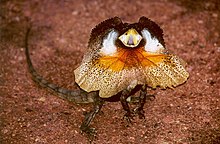
The retention of the basic tetrapod body form by lizards makes it tempting to assume any similar animal, alive or extinct, is also a lizard. However, this is not the case, and lizards are part of a well-defined group.
The first reptile was superficially lizard-like, but had a solid, box-like skull, with openings only for eyes, nostrils, etc (termed Anapsid).[citation needed] These organisms later gave rise to two new groups with additional holes in the skull to make room for and anchor larger jaw muscles.[citation needed] Those with a single hole, the Synapsids, became modern mammals.[citation needed] The Diapsids, possessing two holes, continued to diversify.[citation needed] The Archosaurs retained the basic Diapsid skull, and gave rise to a bewildering array of animals, most famous being the dinosaurs and their descendants, birds.[citation needed] The Lepidosaurs began to reduce the skull bones, making the skull lighter and more flexible.[citation needed] Modern tuataras retain the basic Lepidosaur skull, distinguishing them from true lizards in spite of superficial similarities.[citation needed] Squamates, including snakes and all true lizards, further lightened the skull by eliminating the lower margin of the lower skull opening.[citation needed]
Relationship to humans

Most lizard species are harmless to humans. Only the very largest lizard species pose threat of death; the Komodo dragon, for example, has been known to stalk, attack, and kill humans. The venom of the Gila monster and beaded lizard is not usually deadly but they can inflict extremely painful bites due to powerful jaws. The chief impact of lizards on humans is positive as they are significant predators of pest species; numerous species are prominent in the pet trade; some are eaten as food (for example, Green Iguanas in Central America); and lizard symbolism plays important, though rarely predominant roles in some cultures (e.g. Tarrotarro in Australian mythology). The Moche people of ancient Peru worshiped animals and often depicted lizards in their art.[2] According to a popular legend in Maharashtra, a Common Indian Monitor, with ropes attached, was used to scale the walls of the Sinhagad fort in the Battle of Sinhagad.[3]
Classification
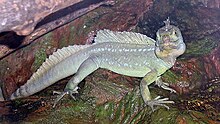
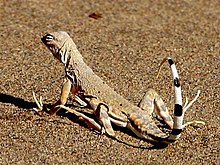

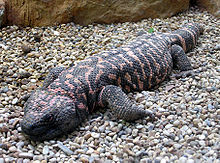
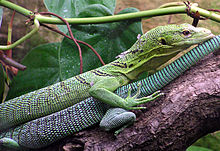
Suborder Lacertilia (Sauria) - (Lizards)
- Family Bavarisauridae
- Family Eichstaettisauridae
- Infraorder Iguania
- Family Arretosauridae
- Family Euposauridae
- Family Corytophanidae (casquehead lizards)
- Family Iguanidae (iguanas and spinytail iguanas)
- Family Phrynosomatidae (earless, spiny, tree, side-blotched and horned lizards)
- Family Polychrotidae (anoles)
- Family Leiosauridae (see Polychrotinae)
- Family Tropiduridae (neotropical ground lizards)
- Family Liolaemidae (see Tropidurinae)
- Family Leiocephalidae (see Tropidurinae)
- Family Crotaphytidae (collared and leopard lizards)
- Family Opluridae (Madagascar iguanids)
- Family Hoplocercidae (wood lizards, clubtails)
- Family Priscagamidae
- Family Isodontosauridae
- Family Agamidae (agamas)
- Family Chamaeleonidae (chameleons)
- Infraorder Gekkota
- Family Gekkonidae (geckos)
- Family Pygopodidae (legless lizards)
- Family Dibamidae (blind lizards)
- Infraorder Scincomorpha
- Family Paramacellodidae
- Family Slavoiidae
- Family Scincidae (skinks)
- Family Cordylidae (spinytail lizards)
- Family Gerrhosauridae (plated lizards)
- Family Xantusiidae (night lizards)
- Family Lacertidae (wall lizards or true lizards)
- Family Mongolochamopidae
- Family Adamisauridae
- Family Teiidae (tegus and whiptails)
- Family Gymnophthalmidae (spectacled lizards)
- Infraorder Diploglossa
- Family Anguidae (glass lizards)
- Family Anniellidae (American legless lizards)
- Family Xenosauridae (knob-scaled lizards)
- Infraorder Platynota (Varanoidea)
- Family Varanidae (monitor lizards)
- Family Lanthanotidae (earless monitor lizards)
- Family Helodermatidae (gila monsters & beaded lizards)
- Family Mosasauridea (marine lizards)
References
- ^ Cooper WE, Vitt LJ (2002). "Distribution, extent,
and evolution of plant consumption by lizards". J. Zool. 257: 487–517. doi:10.1017/S0952836902001085.
{{cite journal}}: line feed character in|title=at position 22 (help) - ^ Berrin, Katherine & Larco Museum. The Spirit of Ancient Peru:Treasures from the Museo Arqueológico Rafael Larco Herrera. New York: Thames and Hudson, 1997.
- ^ Auffenberg, Walter (1994). The Bengal Monitor. University Press of Florida. p. 494. ISBN 0813012953.
- General references
- Byiiuo, John L.; King, F. Wayne (1979). The Audubon Society Field Guide to Reptiles and Amphibians of North America. New York: Alfred A. Knopf. p. 581. ISBN 0394508246.
- Capula, Massimo (1989). Simon & Schuster's Guide to Reptiles and Amphibians of the World. New York: Simon & Schuster. ISBN 0671690981.
{{cite book}}: Unknown parameter|coauthors=ignored (|author=suggested) (help) - Cogger, Harold; Zweifel, Richard (1992). Reptiles & Amphibians. Sydney: Weldon Owen. ISBN 0831727861.
- Conant, Roger; Collins, Joseph (1991). A Field Guide to Reptiles and Amphibians Eastern/Central North America. Boston, Massachusetts: Houghton Mifflin Company. ISBN 0395583896.
- Ditmars, Raymond L (1933). Reptiles of the World: The Crocodilians, Lizards, Snakes, Turtles and Tortoises of the Eastern and Western Hemispheres. New York: Macmillian. p. 321.
- Freiberg, Dr. Marcos; Walls, Jerry (1984). The World of Venomous Animals. New Jersey: TFH Publications. ISBN 0876665679.
- Gibbons, J. Whitfield; Gibbons, Whit (1983). Their Blood Runs Cold: Adventures With Reptiles and Amphibians. Alabama: University of Alabama Press. p. 164. ISBN 978-0817301354.
- Rosenfeld, Arthur (1989). Exotic Pets. New York: Simon & Schuster. p. 293. ISBN 067147654.
{{cite book}}: Check|isbn=value: length (help)
